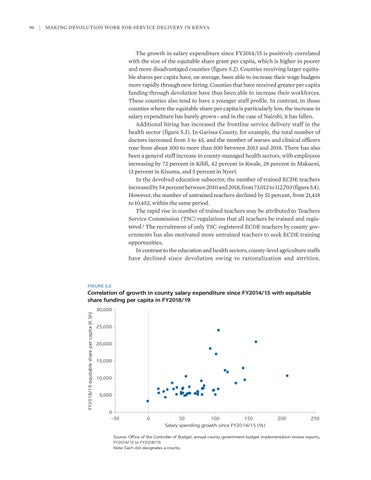|
Making Devolution Work for Service Delivery in Kenya
The growth in salary expenditure since FY2014/15 is positively correlated with the size of the equitable share grant per capita, which is higher in poorer and more disadvantaged counties (figure 5.2). Counties receiving larger equitable shares per capita have, on average, been able to increase their wage budgets more rapidly through new hiring. Counties that have received greater per capita funding through devolution have thus been able to increase their workforces. These counties also tend to have a younger staff profile. In contrast, in those counties where the equitable share per capita is particularly low, the increase in salary expenditure has barely grown—and in the case of Nairobi, it has fallen. Additional hiring has increased the frontline service delivery staff in the health sector (figure 5.3). In Garissa County, for example, the total number of doctors increased from 3 to 45, and the number of nurses and clinical officers rose from about 300 to more than 500 between 2013 and 2018. There has also been a general staff increase in county-managed health sectors, with employees increasing by 72 percent in Kilifi, 42 percent in Kwale, 28 percent in Makueni, 13 percent in Kisumu, and 5 percent in Nyeri. In the devolved education subsector, the number of trained ECDE teachers increased by 54 percent between 2010 and 2018, from 73,012 to 112,703 (figure 5.4). However, the number of untrained teachers declined by 51 percent, from 21,418 to 10,452, within the same period. The rapid rise in number of trained teachers may be attributed to Teachers Service Commission (TSC) regulations that all teachers be trained and registered.1 The recruitment of only TSC-registered ECDE teachers by county governments has also motivated more untrained teachers to seek ECDE training opportunities. In contrast to the education and health sectors, county-level agriculture staffs have declined since devolution owing to rationalization and attrition.
FIGURE 5.2
Correlation of growth in county salary expenditure since FY2014/15 with equitable share funding per capita in FY2018/19 FY2018/19 equitable share per capita (K Sh)
96
30,000 25,000 20,000 15,000 10,000 5,000 0 –50
0
50 100 150 Salary spending growth since FY2014/15 (%)
200
250
Source: Office of the Controller of Budget, annual county government budget implementation review reports, FY2014/15 to FY2018/19. Note: Each dot designates a county.


